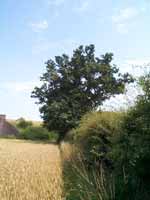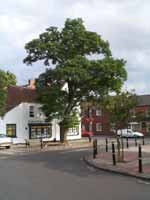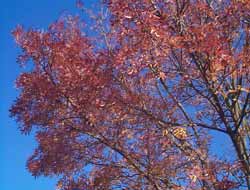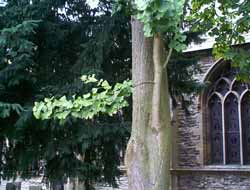| This
survey reports on the freestanding trees in public places
and farmland in the parish. With only one or two exceptions
no attempt has been made to examine the trees in gardens.
By November 2003 the survey was not competed.
The survey identified each tree, noted anything of interest
about it and measured its girth at chest height to get an
estimate of its age. The formula used for this can be seen
by clicking here.
In most cases single trees are reported in the database, but
where there are several spaced in a line along a road a single
database entry will cover them all.

Oak tree in hedge along
the parish boundary near the Linear Photo: Peter Allen |
Farmland
trees.
Until the middle part of the last century there were
far more farmland trees in Bingham than at present.
Ash, oak and elm trees grew in the hedgerows and air
photographs taken in the 1950s show a far greater number
of trees for every hundred metres than is now evident.
Some were felled when the hedges were grubbed up, but
many old, hollowed or split trees either came down naturally
or had to be felled. The elm disappeared as a result
of disease. Ash is the commonest survivor, followed
by oak. Small-leaved elm is struggling to re-establish
itself, often from the stumps of felled, diseased trees
in the hedgerows. Sycamore trees are rare in hedgerows.
In some hedges field maple, wych elm and crab apple
have been allowed to grow into trees. Variety has been
provided in the last twenty years or so with several
species planted along some of the hedgerows. These include
horse chestnut, alder, cherry, walnut, silver birch,
rowan, lime and beech. The oldest of the hedgerow trees
is an English oak on Top Brackendale farm. Its girth
is 410cm, suggesting an age of about 215 years.
White willow and crack willow are to found around old
ponds in all parts of the parish. Tall Lombardy poplars
are usually found near farm buildings. In some cases
both poplar and Scots pine occur along hedgerows where
there used to be buildings that are now demolished.
|
Municipal
planting
Within the town many of the trees that grew in or around
the remaining fields and orchards became either incorporated
in gardens or were lost when these spaces were filled
with housing. This loss of freestanding trees, however,
has probably been made up with municipal plantings along
the streets and in other public places largely since
the Second World War. Norway maple is the commonest
street tree, but whitebeam and Swedish whitebeam are
also favoured. Beside these, there is a bewildering
variety of trees and shrubs planted in the open spaces
in post-1960s housing developments, not all of which
have been recorded in this survey.
Uncommon species
Several species have been recorded only once, but this
may change when the survey is complete. Among these
are the Gingko buloba and Prunus serrula (var.Tibetan
Cherry) in the churchyard and the narrow-leaved ash
(Fraxinus angustifolia) in the Market Place. Wellingtonia
(Sequoiadendron giganteum), mulberry (Morus nigra) and
monkey puzzle tree (Araucaria araucana) are present
in private gardens, but visible from the street, and
appear to be the only specimens of those species in
Bingham. There are only three recorded specimens of
the false acacia (Robinia pseudoacacia). Silver maple
(Acer saccharinum) is also very uncommon outside gardens.
There are several species of conifer only present either
in the cemetery or in the schools. |
 False acacia growing in
Market Place Photo: Peter Allen
False acacia growing in
Market Place Photo: Peter Allen |

Close-up of narrow-leaved
ash in Market Place in its full Autum colour. Photo: Peter
Allen |
Cemetery
The cemetery on The Banks is the nearest thing Bingham
has to an arboretum. There are 150 trees and over 40 different
species of tree and shrub. The most unusual species planted
here including Irish yew, Corsican pine, Bhutan pine,
Lawson cypress, Douglas fir and deodar among the older
trees. Younger trees range from common types like rowan,
lime and cherry to shrubs like cotoneaster, spotted laurel,
magnolia, Viburnum sp and various ornamental specimens
commonly sold in garden centres nowadays.
The cemetery divides up into three nearly equal parts
and, although there has obviously been tree planting at
all times since opening, average ages of trees cluster
into five quite distinct groups. These closely correlate
with the opening of the cemetery in 1888, the end of the
First World War, the end of the Second World War, c1970
and post 1985. There are one or two with ages of around
100, which may have been planted to celebrate the start
of the twentieth century. |
| The northern third
of the cemetery is the original part and was opened
in 1888. Beech, horse chestnut, lime and a single deodar,
planted around the periphery at that time survive, as
does a single scarlet oak alongside the central path.
If these trees are regarded as having been planted in
the open they yield an average age of 106. The remainder
of the trees in this part of the cemetery show four
clear groups of ages if regarded as being partially
hemmed in (see the dating method for definitions). The
oldest is 82.5 years (an average from 22 datable trees),
which just post-dates the end of the First World War.
The next is 55.4 (an average of 15 trees), which falls
just after the Second World War. The third is 31.5 years,
while the fourth consists of several shrubs that are
generally 20 years or less.
The middle part of the cemetery,
which begins beyond the third of the east-west crossing
paths, shows two clusters of ages; one with an average
of 33 years; the other of 18.
The southern extension of
the cemetery, which was acquired in 1995 was planted
shortly after acquisition.
To enter the database and conduct
your own searches click
here. |
 Gingko tree growing in
the Bingham churchyard Photo: Peter Allen
Gingko tree growing in
the Bingham churchyard Photo: Peter Allen |
|
![]()




